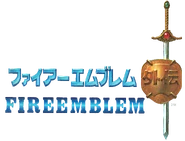
The boxart for Fire Emblem Gaiden
Fire Emblem Gaiden (ファイアーエムブレム外伝 Faiā Emuburemu Gaiden) is the second installment in the Fire Emblem series developed by Intelligent Systems and published by Nintendo. The game was released on March 14, 1992 in Japan. It is also the second and final Fire Emblem series title to be released exclusively on the Famicom (Nintendo Entertainment System). It serves as a side story to the original game ("Gaiden" is literally Japanese for "side story"). Set in the same game world, the events of Fire Emblem Gaiden actually take place on a different location: the continent Barensia, and thus have no bearing on the first game's narrative. However, a few characters from the original game, such as the pegasus knight sisters, do make return appearances. The game was referenced in Super Smash Bros. Brawl with one music track and some Stickers.
Plot
The game follows two protagonists, life-long friends Alm and Cellica, over the course of five chapters and takes place in two kingdoms on the continent of Barensia: Rigel and Sofia. The world map is slowly revealed for players to traverse through the game's five chapters. Over the course of the game, it is revealed to both Alm and the player that he is actually the prince of Rigel, whereas Cellica is the princess of Sofia. Fire Emblem Gaiden was the first game in the series where the main character could promote. Alm begins the game as a Fighter before eventually promoting to Hero. Cellica is a Priestess, and she promotes into Princess.
Characters
See main article: Fire Emblem Gaiden Characters
Gameplay
While the basic battle engine and formula from the original game are still present in Fire Emblem Gaiden, a number of new gameplay features were added or changed:
- Regular stat caps were raised to 40.
- Certain classes feature branching promotion trees, allowing the player to select a character's promotion class.
- Class change is done in special shrines, without the need to use special items.
- Only special weapons need be equipped, and neither these nor the unit's default weapons will ever break.
- Spells are learned through leveling up, and they drain the spellcaster's hit points with each use, but would take the unit's Power stat into account for determining the amount of damage dealt or healed (something that didn't happen in the first installment of the series)
- The game also features an overworld map that players can travel through between battles and towns that can be freely explored, with more territory becoming available as the game progresses.
It's a popular belief that, despite the numerous changes to the Fire Emblem formula, most of the later games in the series reverted back to the gameplay of the original Fire Emblem before evolving into new directions. Such claim is false, however, as a number of new features are in fact revisions or further developments of Gaiden's novelties, such as Seisen no Keifu's limited and permanent items and class-change system, The Sacred Stones's navigable world map and branching class promotions, and Radiant Dawn's tiered promotions and branching storylines.



